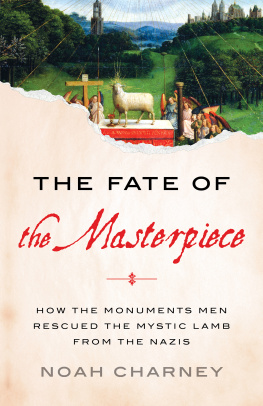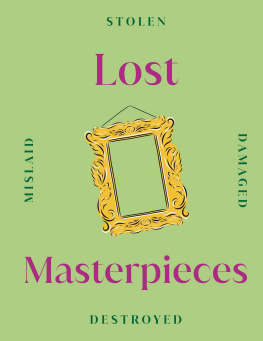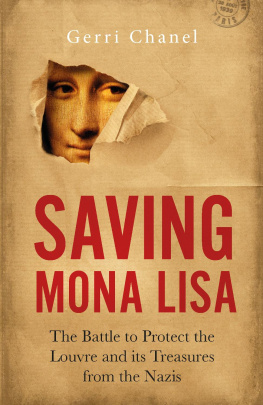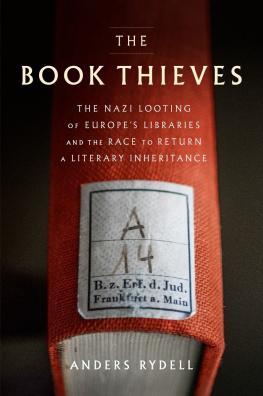Praise for Stealing the Mystic Lamb
A Mail on Sunday Book of the Week
International Bestseller
[A]ction-packed.... In scrupulous detail, Charney divulges the secrets of the revered paintings past, and in doing so, gives readers a history lesson on art crime, a still-prospering black market.
Christian Science Monitor
Charneys wonderfully learned and entertaining book tells us about all the indignities this famous image has endured through the centuries.... Charney tackles some important subjects (the creation of the modern art-stealing industry, our sensible obsession with almost burglar-proof museums), but he wears his learning lightly and the next extraordinary tale is only ever a few pages away.... It is good to hear... all the... bizarre tales this innovative and elegant book has to tell.
Catholic Herald
I am awed by the magnitude of the things I dont know. Although art is surely a subjective experience, expertise is often required to nudge one along to appreciation. I would not have paused to look at The Mystic Lamb without Charneys backstory. It still does not appeal to me as a thing of beauty or as inspiration. But I confess, Charney has me wishing I could see the Altarpiece in Ghent.
Providence Journal
Charney unsnarls the tangled history of Jan van Eycks 15th-century The Ghent Altarpiece (aka The Mystic Lamb), the most desired and victimized object of all time. With a novelists sense of structure and tension, the author adds an easy familiarity with the techniques of oil painting and with the intertwining vines of art and political and religious history.... A brisk tale of true-life heroism, villainy, artistry, and passion.
Kirkus
It is the fate of great, universal works of art such as The Mystic Lamb to become the emblems of nationalism, and [this] book works best when it is exploring this theme.
Mail on Sunday (UK)
Fast-paced and readable.... This is an intriguing blend of reportage and art history, providing what is in effect a remarkable biography of this beautiful and tough survivor.
Sunday Times
Richly compelling.
ArtInfo
A fascinating piece of research.
El Pais (Spain)
Well-written and packed with interesting comments.
Het Laaste Nieuws (Belgium)
THE FATE OF THE MASTERPIECE
THE FATE OF THE MASTERPIECE
How the Monuments Men Rescued the Mystic Lamb from the Nazis
NOAH CHARNEY

Copyright 2014 by Noah Charney.
Published in the United States by PublicAffairs,
a Member of the Perseus Books Group
All rights reserved.
Printed in the United States of America.
No part of this book may be reproduced in any manner whatsoever without written permission except in the case of brief quotations embodied in critical articles and reviews. For information, address PublicAffairs, 250 West 57th Street, 15th Floor, New York, NY 10107.
PublicAffairs books are available at special discounts for bulk purchases in the U.S. by corporations, institutions, and other organizations. For more information, please contact the Special Markets Department at the Perseus Books Group, 2300 Chestnut Street, Suite 200, Philadelphia, PA 19103, call (800) 810-4145, ext. 5000, or e-mail special.markets@perseusbooks.com.
Library of Congress Control Number: 2013958257
ISBN 978-1-61039-489-5 (EB)
To Urka, the love of my life,
and to Hubert van Eyck, who taught me the joys of gnawing on ones own foot
CONTENTS
As the oak door to the chapel swings open, one is first struck by the scents: the cool, ancient stone of the walls of Saint Bavo Cathedral, the smell of frankincense, and then the surprising notes of old wood, linseed oil, and varnish. The cathedral in Ghent, Belgium, abounds with stunning religious art, but one artwork stands out among the rest. After six hundred years of nearly constant movement, The Ghent Altarpiece is at last back in the cathedral for which it was painted.
Jan van Eycks masterpiece has been involved in six separate thefts, dwarfing the next runner-upa Rembrandt portrait, lifted from Londons Dulwich Picture Gallery on a mere four occasions. From enduring questions surrounding the movement, through theft and smuggling, of the altarpiece as a whole to the mystical symbolism of its content, the altarpiece has haunted scholars and detectives, hunters and protectors, interpreters and worshippers.
It is one of art historys great unsolved mysteries.
Those who stand before the altarpiece cannot but feel overwhelmed by its monumentality. The Ghent Altarpiece comprises twenty individual painted panels linked in a massive hinged framework. It is opened on its hinges for religious holidays but remains closed for most of the year, at which point only eight of the twenty panels, which were painted on both recto and verso (front and back sides), are visible. The subject matter of the verso panels, visible when the altarpiece is closed, is the Annunciation: The angel Gabriel tells Mary that she will bear the Son of God. Portraits of the donors who paid for the altarpiece, and their patron saints, also grace the back. The altarpiece has a puzzle-box appearance, and inside its treasures lie patiently in wait for decipherers. When open, the altarpieces center displays an idealized field full of figures: saints, martyrs, clergy, hermits, righteous judges, knights of Christ, and an angelic choir, all making a slow pilgrimage to pay homage to the central figurea Lamb on a sacrificial altar, standing proudly, while it bleeds into a golden chalice. This scene is referred to as The Adoration of the Mystic Lamb. The precise iconographic meaning of the Adoration of the Mystic Lamb panel and the meaning of the dozens of obscure symbols within it have been the subject of centuries of scholarly debate.
Above the vast field of the Adoration of the Mystic Lamb, in the upper panels, God the Father (or is it Christ?a question van Eyck wants us to ask ourselves) sits enthroned, with Mary and John the Baptist on either side. The figure has a hand raised in blessing, a hand painted with an astonishing realism: veins bulge and tiny hairs curl out of the pore-scored skin. At his foot, a crown is clustered in light-reflecting jewels; the fringe of his cloak is woven in gold threads, and above his head arch rune-like inscriptions. Individual hairs were lovingly painted into his beard, and his almond eyes express a power and a weariness that are altogether human. The level of minute detail in so enormous an artwork is unprecedented. Until the altarpiece was painted, only portrait miniatures and illuminated manuscripts contained such detail. Nothing like this intricacy had ever been seen before on such a grand scale, by artists or admirers. The great art historian Erwin Panofsky famously wrote that van Eycks eye functioned as a microscope and a telescope at the same time. Viewers of The Ghent Altarpiece, Panofsky explained, are privy to Gods vision of the world, capturing some of the experience of Him who looks down from heaven, but can number the hairs on our head. In The Ghent Altarpiece, jewels shine with refracted light. One can see individual hairs on the manes of horses. Each of the altarpieces hundred-plus figures has been given personalized facial features. Each figures face is unique and retains the detail of a portraitsweat, wrinkles, veins, and flared nostrils. Details range from the mundane to the elegant. Viewers can make out tufts of grass, the wrinkles in an old, worm-eaten apple, and warts on double chins. But they can also see the reflection of light caught in a perfectly painted ruby, the folds of a gilded garment, and individual silvery hairs amid the chestnut curls of a beard. The secret weapon that permitted such detail was oil paint. Because oil paints are translucent, artists can build up layer upon layer without covering up what lies beneath. The preferred medium before van Eycks time, egg-based tempera, was essentially opaque. One layer blotted out the previous one. Oil allowed for a great deal more subtlety and was also easier to control. Van Eyck used some brushes that were so small as to contain only a few animal hairs for bristles, permitting an entirely new level of intricacy. The result is a visual feast, a galaxy of painterly special effects that at once dazzle and provide days of viewing interest, prompting viewers to examine the painting from afar and up close, to decipher as well as to bask in its beauty.








